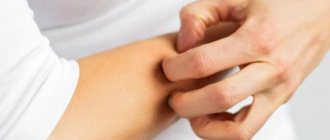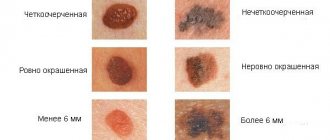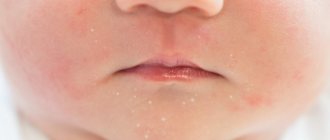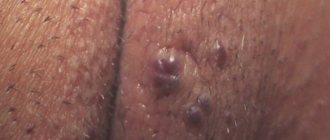Probably each of us, at least once in our lives, has heard or said the phrase “I’m itching from nerves.” And this is not a figurative expression at all! Stressful situations and emotional shocks, nervous tension or central nervous system disorders - all these factors have an extremely negative impact on the human body. As a result, he cannot stay away from the situation and reacts to it in a specific way.
One of the most common symptoms is itching. At the same time, scabies from nerves is not at all similar to the disease caused by parasites - scabies mites. In the case when the whole body itches due to nervousness, we are talking about the development of pseudo-allergy. The causes and symptoms of nervous itching of the skin need to be known in order to be able to recognize the ailment and respond correctly to it.
How you can itch due to nervousness: symptoms
Psychogenic itching can manifest itself in the form of:
- hives (usually on the hands, face, ears, genital area);
- itchy rash that occurs against the background of excessive sweating;
- severe itching all over the body;
- unbearable scabies in certain parts of the body, usually in the distal parts of the limbs.
Often, psychogenic skin discomfort is felt as a burning sensation, reminiscent of a burn.
Different manifestations of nervous scabies can appear separately, or they can replace or complement each other.
The intensity of the ailment can vary from hour to hour, day to day, month to month. Sometimes symptoms can completely go away for several days, months and even years, and sometimes they begin to plague you with incredible force.
The intensity of scabies often increases at night, leading to severe chronic insomnia, which in turn causes a deterioration in the person's psychological state and increases bodily symptoms of anxiety.
In most cases, malaise is accompanied by other physical manifestations of mental discomfort - dizziness, palpitations, increased fatigue, indigestion, etc.
Notalgia paresthetica is considered an isolated mononeuropathy, manifested by chronic focal itching or paresthesia in the area of the scapula and the skin surrounding this area. There are no specific manifestations of the disease, but manifestations of chronic itching in the form of scratches and abrasions are determined. The etiology of the disease remains unknown, however, there is an assumption that the cause lies in irritation of the posterior nerve roots in the T2-T6 region, which occurs due to degenerative changes in the vertebrae. In this article, we describe a case of notalgia paresthetica in a 55-year-old woman. The patient came to us for medical help with complaints of tingling in the area of the lower angle of the left scapula. Itching first appeared 7 years ago and turned into tingling 4 months ago. Apart from excoriations and a vague focus of hyperpigmentation, no specific skin manifestations of the disease were observed. Skin biopsy showed thinning of the epidermis with pigment loss. The patient was treated with 600 mg gabapentin daily and capsaicin cream with unsatisfactory results.
Introduction
The term nostalgia paresthetica comes from the Greek word "notos", meaning "back", and was first described by Astvatsaturov in 1934. This condition refers to isolated mononeuropathies with chronic localized itching or paresthesia in the scapular region. There are no specific skin manifestations of the disease, with the exception of secondary manifestations of chronic skin itching, such as scratches and abrasions. We described the first case of nootalgia paresthetica reported in Korea in a 55-year-old woman.
Clinical case
A 55-year-old woman came to our clinic for medical help with complaints of a tingling sensation in the area of the lower angle of the left scapula. According to the patient, itching has existed for 7 years with transformation into pain and tingling over the last 4 months. No peculiarities were found in the patient's medical history. Before visiting our clinic, the patient underwent a comprehensive neurological examination in multiple clinics, including an MRI examination of the spine without identifying any pathology. We could not detect any specific lesions on the skin other than excoriations and vague areas of hyperpigmentation (Fig. 1). We performed a skin biopsy from a lesion on the back. Pathohistologically, we found only thinning of the epidermis and the zone of pigment incontinence (Fig. 2). The S-100 protein test was also negative. The patient was diagnosed with Notalgia paresthetica based on the clinical picture. The patient received treatment: Gabapentin 600 mg daily and capsaicin cream externally. Unfortunately, the response to treatment was unsatisfactory.
Discussion
Notalgia paresthetica is a neurocutaneous disorder affecting middle-aged and older adults, occurring twice as often in women as in men. The etiology of the disease remains unknown, although it is assumed that the itching is caused by irritation of the posterior nerve roots in the T2-T6 region, which is associated with degenerative changes in the vertebrae. When examining 12 patients, 9 of them were diagnosed with spinal pathology using R-graphy, including manifestations of osteoarthritis, such as kyphosis, kyphoscoliosis and hyperostosis. Pacresthetic notalgia is usually diagnosed by functional symptoms. Itching is the most common symptom of the disease and is characterized by intermittency, paroxysmal and variable intensity. The disease may be accompanied by paresthesias such as pain, burning sensation, feeling of heat or cold, tingling, numbness and even a foreign body sensation. This leads to chronic scratching and rubbing of the affected area, which in turn manifests itself as hyperpigmentation, and its symptoms resemble the macular form of amyloidase. Secondary manifestations are also the localization of the process in the area of dermatomes T2-T6, which corresponds to the subscapular paravertebral zone. In most cases, notalgia paresthetica is a unilateral process that can equally often affect either side. However, there are bilateral forms and forms with an emphasis on the interscapular region. It is important to clinically exclude other itchy dermatoses in the back area, such as pigmented contact dermatitis, focal parapsoriasis, and neurodermatitis. A more difficult disease for differential diagnosis is early cutaneous amyloidosis, localized on the back even in the initial stages. In such cases, the emphasis in diagnosis should be on the course of the disease and searching for skin lesions in other places.
The results of our histological examination, such as post-inflammatory melanosis, basal hyperpigmentation and pigment incontinence, do not differ significantly from the cases described in other cases. Cutaneous amyloidosis has been described in some cases. This is presumably the result of chronic friction and degeneration of keratinocytes and their degeneration into the protein amyloid. Epidermal proliferation, as seen in lichen simplex chronicus, usually appears in the affected area where itching and chronic friction are present. However, in contrast to this, our patient demonstrated thinning of the epidermis. An explanation for this may be long-term use of topical glucocorticosteroids on the itchy area. This could also lead to a decrease in hyperpigmentation in the lesion.
Springall et al. previously described an increase in sensory epidermal innervation in the lesion, which contributes to the development of disease symptoms. They found that frozen sections of lesions contained high amounts of intradermal protein 9.5 immunoreactive nerve fiber gene products compared with healthy skin from the same patients and control subjects. In a more recent study, Inaloz et al. demonstrated a significant increase in cutaneous nerves using the neural marker S-100. However, Beck S-100 staining did not show nerve proliferation in this case.
To date, there is no specific treatment for notalgia paresthetica, and all published work on the treatment of this condition is anecdotal. Topical capsaicin is the most widely used drug among dermatologists. Transcutaneous electrical nerve stimulation, gabapentin, oxcarbazepine, and botulinum toxin, and narrowband UVB radiation have recently shown promising results. However, in most cases, treatment results were disappointing. Our patient also received moderate doses of gabapentin and topical capsaicin, but we did not receive a satisfactory response to therapy. Non-dermatological, non-invasive treatment for notalgia paresthetica should also include manual spinal work, physical therapy, massage, neck traction, strengthening of the neck muscles, therapy with non-steroidal anti-inflammatory drugs and muscle relaxants. Successful treatment of the disease requires a multidisciplinary approach involving dermatologists, radiologists, orthopedic surgeons and neurologists.
Physiological causes of rash, urticaria, scabies due to nerves
The brain itches, not the skin.
In order for a person to feel itching, the motor, affective and sensory areas in his brain must simultaneously be activated, which will form the corresponding sensation. Therefore, any scabies may always have a mental component.
People experiencing psychogenic itch constantly irritate their skin. Scratching provides temporary relief. But it activates central and peripheral sensitivity, reducing the threshold for the perception of unpleasant sensations.
When scratching, inflammatory mediators are released in the skin, which increase peripheral sensitivity. When inflammation becomes chronic, it accelerates signal transmission through the spinal cord and enhances its processing in the brain. Central sensitization occurs.
The habit of psychogenic itching is always formed through a vicious feedback circle.
- There is a desire to scratch.
- The person itches and feels some relief.
- Positive reinforcement is triggered - if you scratch yourself, it becomes easier.
- But scratching provides only short-term relief. But in fact, it only intensifies the itching, as it exacerbates central and peripheral sensitivity to irritants of this kind.
- As the sensitivity has increased, you want to itch even more. Combing again provides short-term relief and again forms positive reinforcement for this action. And so on ad infinitum.
1.Skin itching
Itchy skin
- this is a need for mechanical action on the skin, often very acute. As a rule, the first thing that happens when itching occurs is involuntary scratching. There are no specific receptors responsible for skin itching. An unpleasant skin sensation called “itching” is usually a very mild pain and a feeling of being touched or moved across the skin. Tactile and pain receptors are enough to trigger the need to scratch. It has been noticed that only areas covered with epithelium can itch. This proves that only the nerve endings of the skin are capable of producing itching.
Several mediators (substances that transmit sensation to the brain) of skin itching are considered
, although practice shows that none of them is decisive or necessary compared to the others.
Histamine.
The release of histamine, as a mediator of skin itching, as they say, “lies on the surface”, since this substance is closely related to all kinds of allergic reactions, incl. with an itching component. However, it has been noted that not all patients with high histamine levels experience the need to scratch. Conversely, antihistamines in some cases do not help with itchy skin.
Bile acids.
An increased concentration of bile acids in the skin often accompanies itchy skin. But it is not a necessary and sufficient condition for skin irritations.
Also, the need to itch is believed to involve serotonin, opiates, and cytokines.
Itching is always a symptom
. Even if the skin itches simply because it is dry, this indicates disturbances in its water-lipid metabolism. Scratching as a result of insect bites is a consequence of a violation of the integrity of the epithelium or substances introduced under the skin. One way or another, itching is always a consequence of disturbances in the functioning of the body or mechanical and chemical damage to the skin itself.
A must read! Help with treatment and hospitalization!
Why psychogenic itching can be contagious
The “contagious” effect of nervous scabies is known to most people. Probably everyone has noticed that if you look at how furiously another person is itching, you want to start itching yourself, even if there was no itching before.
In sensitive people, psychogenic itching can begin from seeing pictures of insects or scratched skin. The more prone a person is to developing rashes and scabies due to nervousness, the faster he gets infected. Neurotic patients are usually more susceptible to such “infection” than people with a stable psyche.
However, to one degree or another, the desire to itch is always transmitted to a person if he sees something related to scratching. The exact mechanism of spread of such an “infection” has not been fully established. It is assumed that mirror neurons are to blame, which allow us to feel what others feel and communicate thanks to this.
What causes psychogenic itching?
Psychogenic itch is directly related to depression, anxiety and mental disorders. The following symptoms are characteristic of this disease:
- absence of skin changes (redness, peeling, rashes);
- special activity at the peak of emotions and nervous tension.
Doctors note that psychogenic itching often manifests itself in people with a shaky and unstable psyche. Activity can also occur at night. This is exactly the bell that reminds you that it’s time to seek help from a qualified doctor.
Constant itching requires serious medical diagnosis. Only when the cause of the itching is identified, the doctor prescribes specific treatment. According to the observations of our specialists, the treatment of small, adult and mature patients is similar. An integrated approach to solving a problem such as psychogenic itching will help alleviate the patient’s condition.
Mental basis of nervous scabies
There are several theories explaining the mental basis of the occurrence of nervous scabies.
The simplest and most understandable is the cognitive-behavioral model, according to which the symptom of psychogenic itching is based on catastrophizing.
- Against the background of excitement, a person experiences mild itching. Which is normal, since skin hypersensitivity often develops under stress.
- However, instead of not paying attention to the slight discomfort, the person gets scared.
- Begins to consider the desire to scratch as a symptom of some serious illness.
- Constantly itches and thinks about how he should itch and how terrible it is.
- Quite quickly, this line of thinking leads to the formation of a vicious circle and the development of persistent psychogenic itching.
There is also the concept of “personal skin”, somatoform dissociation, a psychobiological concept. They all explain the development of nervous itching in different ways, but in essence they only complement each other.
It has been noticed that nervous scabies most often affects people who are depressed and those who suffer from social anxiety.
Patients with chronic pruritus, even if due to dermatological causes such as psoriasis, often show signs of the classic Beck triad of depression. That is, they evaluate the present as hopeless, do not see the future, and do not value themselves at all.
These are often people with low psychological stability and self-efficacy.
All these signs of mental discomfort are even more noticeable in patients with chronic scabies, in whom it is not possible to diagnose any dermatological disease.
Features of the treatment of itching due to nervousness
Now let’s move directly to the question that is relevant for people in this situation: “I’m itching from nerves - what to do?” First of all, it is necessary to remember that without eliminating the source of the ailment, getting rid of it will be very problematic.
In most cases, with “nervous” itching, sedatives in tablets or syrups help well: valerian, Persen, Sedavit, Novo-Passit. The drug Bifren in capsules perfectly relieves psycho-emotional stress, eliminates mood swings and increases the endurance of the brain and nervous system.
Note. If the body itches due to nervousness, and this process is accompanied by other unpleasant symptoms (tachycardia, heart pain) caused by extreme stress, instead of herbal sedatives, you should resort to the use of heart drops or tablets: Corvalol, Corvaltab, Tricardin, Corvalment or Barboval. Drops are taken in a dosage of 20-30 drops per half glass of water or a teaspoon of sugar. Gelatin-coated tablets are administered sublingually (under the tongue).
What does nervous itching lead to: physical consequences
Unlike some other bodily symptoms of mental discomfort, which impair quality of life but do not cause real harm to health, nervous itching can be accompanied by very real side effects. The main one is scratching.
The skin most often affected is the arms, legs, abdomen, head, neck and face.
Over time, scratches can become permanent. The skin in the affected area thickens and becomes hyperpigmented. The scratches may become infected with the development of severe inflammation.
Characteristic symptoms and possible consequences
It is important to be able to recognize the symptoms of nervous itching and distinguish them from those that occur against the background of various dermatological diseases. It’s worth noting right away: if the problem really is stress or overwork, then you shouldn’t be afraid of life-threatening consequences. But it is still necessary to react to the situation.
As a rule, when a nervous disorder occurs, the limbs are the first to be affected. Nerve rash on the arms or legs is a very common symptom, but it can sometimes affect other areas of the body. This causes unbearable itching, which can disturb a person not only during the day, but also at night.
Some people have itchy nerves not only in their body, but also in their head. This is not only an unpleasant phenomenon, but also fraught with consequences. Of course, it has nothing to do with lice, although against the background of nervous overstrain this pathology is also quite capable of developing.
Nervous itching is characterized by the occurrence of accompanying symptoms in the form of:
- erythema,
- swelling of the skin in the affected area,
- increase in local body temperature,
- hyperemia of the skin.
At the same time, red spots from nerves may appear. They are prone to itching and peeling, and cause their owner not only aesthetic, but also psychological and physical discomfort.
Among the nonspecific symptoms accompanying “nervous” itching, we can note the appearance of:
- lethargy, apathy,
- outbursts of anger or irritation arising against the background of an unbearable and constant desire to scratch the skin,
- general weakness or malaise,
- problems with sleep and falling asleep.
On a note. Body itching due to nervousness is especially acute in children. They perceive it much harder than adults, so they can become irritable, capricious, and whiny.
Possible consequences
Various skin diseases often worsen and develop due to nervousness. First of all, this applies to atopic eczema or dermatitis, psoriasis. And if you can get rid of other symptoms of “nervous” itching by stabilizing a person’s psycho-emotional state, then in the case of the above-mentioned diseases you will have to resort to drug treatment.
Psychogenic itching causes increased mental discomfort
Rash, redness and damage to the skin lead to aggravation of the patient’s mental state. This is especially noticeable when open areas of the body are affected - hands, face.
One of the causes of psychogenic itching is social phobia. Obviously, for a person who is already “afraid” of people, exposing himself to everyone with a face covered in hives and scratches is terribly painful.
A “damaged” appearance increases social phobia, which makes the manifestations of scabies more severe.
As a result, a pathological neural connection is formed. And it becomes more and more difficult to get rid of the nervous itch.
Psychotherapeutic treatment of urticaria and itching from nervous excitement
As with the treatment of any other physical symptom of mental discomfort, psychotherapy occupies the main place in the treatment of scabies due to nervousness. The treatment regimen should include three areas: working with the symptom, with emotions, and with thoughts.
The use of cognitive behavioral therapy, administered by a professional, can help break the vicious cycle of itching.
It is assumed that independent work with the problem is also possible. However, there is no clinically proven data on its effectiveness.
Causes of “nervous” itching
First, let's figure out whether the body can itch from nerves. The answer is clear: yes, and not only in people suffering from psychosomatic disorders or neurological diseases.
The fact is that the human nervous system is a kind of protective mechanism that turns on in response to the influence of various external stimuli. Itching is one of the manifestations of this reaction. But, of course, sometimes it can signal serious disturbances in the functioning of the nervous system.
So, why does itching appear due to nervousness? The main causes of this symptom include:
- prolonged depressive states,
- prolonged exposure to stressful situations,
- the presence of phobias, strong and insurmountable fears,
- panic attacks.
Note. Itching from nerves can be observed in people who have suffered a state of shock or severe nervous shock. If these factors do not cause the development of dermatological diseases (psoriasis, eczema, etc.), then as soon as the person’s psycho-emotional state returns to normal, the unpleasant symptom will go away on its own. If skin pathologies develop, the patient may require special treatment.
At-risk groups
Nervous scabies most often develop in women and young children. This susceptibility is a feature of the development of the nervous system in the fairer sex. As for children, their central nervous system is not yet fully formed, and one of the few ways to react to nervous shock or stress is the occurrence of itching.
Tablets for scabies due to nervousness
To relieve symptoms of psychogenic itching, doctors most often use:
- antidepressants (selective serotonin reuptake inhibitors);
- tricyclic antidepressants, for example, Amitriptyline (along with the antidepressant effect, it exhibits antihistamine properties);
- benzodiazepines (if the patient has acute signs of anxiety);
- GABA analogues (Gabapentin, Pregabalin) are used against the background of the presence of systemic diseases.
All of the drugs listed have side effects. Admission is permitted only with a doctor's prescription.
Emergency self-help for psychogenic itching
The more you scratch, the more it itches. Therefore, the main condition for getting rid of psychogenic itching is not to scratch. To reduce the intensity of unpleasant sensations you can use:
- topical agents with cortisone;
- cold compresses;
- creams and gels with Aloe vera;
- traditional medicine for external use based on soda or oatmeal.
Soda compress
Soda is mixed with water in a ratio of 3 to 1. The resulting mass is applied to the itchy area of the skin.
Can only be used on intact skin. If the area has already been combed and the integrity of the skin is compromised, do not use soda.
Oatmeal compress
Oatmeal is mixed with water to form a paste. Apply to the affected area and keep for 20-30 minutes.
2.Types of itching
Itching can be localized (limited) or generalized (general).
Localized itching
usually simplifies diagnosis because it clearly indicates where to look for the causes of this symptom.
Localized skin itching is characteristic of a number of parasitic and infectious diseases:
- pediculosis;
- scabies,
- lichen,
- skin mite;
- candidiasis;
- rubrophytia;
- enterobiasis.
Most often, local itching occurs in the anus, scrotum and vulva. Also, in some vegetative neuroses, somatic disorders are expressed by itching in areas with a clear localization - where blood circulation is impaired.
Generalized itching
does not apply to certain areas of the skin of the body.
It can manifest itself as a random arrangement of certain scratched points on the body (as, for example, with urticaria) or general itching without skin changes. The second type of general itching occurs for a variety of reasons. The circumstances that trigger the need to itch can be quite unexpected. Generalized itching occurs:
- seasonal;
- senile;
- high altitude (occurs when rising to a high altitude);
- autotoxic (as a consequence of cholestasis);
- chemical (manifested by inhalation or contact with certain substances).
Skin itching of unknown origin deserves special attention when the possibility of a dermatological disease is excluded. If the itching bothers you for a long time - when the possible factors for its occurrence disappear, but the need for scratching remains - a thorough examination is necessary, since skin itching can accompany severe somatic diseases:
- uremia;
- helminthic infestations;
- diabetes;
- liver pathologies;
- pancreatitis;
- gastrointestinal diseases;
- hematological diseases;
- endocrine disorders;
- oncological diseases.
Visit our Dermatology page










